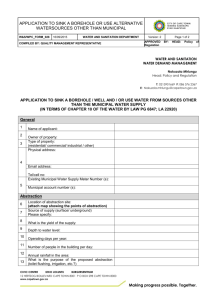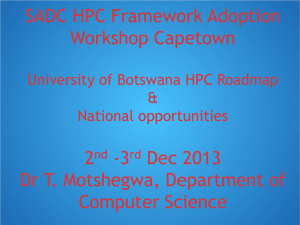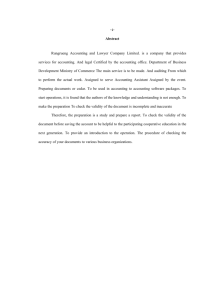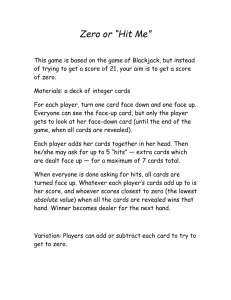3 - Centre for Economic Policy Research
advertisement
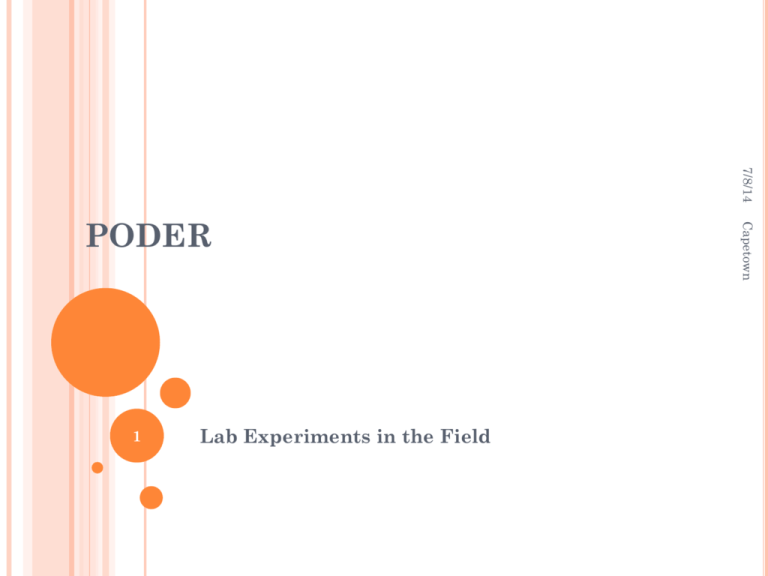
7/8/14 1 Lab Experiments in the Field Capetown PODER OUTLINE FOR TODAY: Leftover from yesterday Multi-site experiments: Solidarity 7/8/14 Capetown 2 NUTS AND BOLTS 7/8/14 Capetown 3 SECOND STEPS: (AFTER THE QUESTION/THEORY) Instrumentation 7/8/14 Construct Validity – how will I test what I want to test? Paper/Pencil or Computer? Timeline of experiment Instructions Capetown Sampling/Randomization What subject pool? How will Treatment be randomized? Analysis Plan What are the units of analysis Power tests 4 SUBJECT SELECTION, I Convenient, inexpensive and relatively homogeneous May behave differently from target population, young, educated, and talk to each other (diffusion) Capetown students 7/8/14 Convenience Samples: Students advantages: Student disadvantages: Classroom: Representative sample of students Environment might affect behavior: Lab: May select certain students Neutral environment Data: Eckel and Grossman ExEc: Students give more to charity in the classroom than in the lab Why? 5 SUBJECT SELECTION, II Groups: 7/8/14 Specialized Elderly Professionals Medical cases Poor Residents of hurricane-vulnerable areas Public officials Population Samples Pluses: External validity, Heterogeneity Minuses: Costly, risk of decreased control, heterogeneity Capetown 6 SUBJECT SELECTION III Subject selection should suit the question you are asking Theory testing: Independent of subject characteristics? Policy (measurement or institutional design): Capetown 7/8/14 Target group subjects Examples: WEIRD people (Henrich, et al. 2010) People from other cultures (Barr and Serra 2010) 7 SECOND STEPS: (AFTER THE QUESTION/THEORY) Instrumentation 7/8/14 Construct Validity – how will I test what I want to test? Paper/Pencil or Computer? Timeline of experiment Instructions Capetown Sampling/Randomization What subject pool? How will Treatment be randomized? Analysis Plan What are the units of analysis Power tests 8 NUTS AND BOLTS, I Lab log. IRB and Ethics Pilot experiments. Lab set-up Subject registration Experimenter(s) Monitor(s) Randomizing Devices Instructions Subject confidence (non-deception) 7/8/14 Capetown 9 LAB BOOK (LUPIA & VARIAN 2010) Capetown 1. State your objectives. 2. State a theory. 3. Explain how focal hypotheses are derived from the theory if the correspondence between a focal hypothesis and a theory is not 1:1. 4. Explain the criteria by which data for evaluating the focal hypotheses were selected or created. 5. Record all steps that convert human energy and dollars into datapoints. 6. State the empirical model to be used for leveraging the data in the service of evaluating the focal hypothesis. (a) All procedures for interpreting data require an explicit defense. (b) When doing more than simply offering raw comparisons of observed differences between treatment and control groups, offer an explicit defense of why a given structural relationship between observed outcomes and experimental variables and/or set of control variables is included. 7. Report the findings of the initial observation. 8. If the findings cause a change to the theory, data, or model, explain why the changes were necessary or sufficient to generate a more reliable inference. 9. Do this for every subsequent observation so that lab members and other scholars can trace the path from hypothesis to data collection to analytic method to every published empirical claim. ELNs: OneNote in Microsoft or Growlybird Notes for the Mac (http://www.growlybird.com/GrowlyBird/Notes.html) 7/8/14 10 NUTS AND BOLTS, I 7/8/14 Capetown Lab log. IRB and Ethics Pilot experiments. Lab set-up Subject registration Experimenter(s) Monitor(s) Randomizing Devices Instructions Subject confidence (non-deception) 11 ETHICS IRB keeps us honest (some countries don’t have) 7/8/14 Focus on potential harm to subjects Consent, debriefing limit harm, but may impact sample Balance between potential benefit and risk Capetown Field experiments: No consent process! Unwitting subject, high potential cost Findley et al 2014. – no consent, no debriefing Correspondence studies on discrimination (more later) Intervention studies: elections, political institutions Facebook study on emotional contagion: no consent, potential risk, very low potential benefit 12 NUTS AND BOLTS, I 7/8/14 Capetown Lab log. IRB and Ethics Pilot experiments. Lab set-up Subject registration Experimenter(s) Monitor(s) Randomizing Devices Instructions Subject confidence (non-deception) 13 NUTS AND BOLTS, II 7/8/14 Capetown Subject questions “Learning periods” Experiment Recording data Termination of experiment Debriefing Subject payment Bankruptcy Backup plan 14 WRITEUP AND REPORTING 7/8/14 Capetown Biases in published data Registration and CONSORT 15 BIASES IN PUBLISHED DATA 7/8/14 Capetown Selective reporting + publication bias => many published studies have p=.05. Data mining and selective presentation of results have been a concern in economics for a long time These concerns are not limited to Economics: Medical trials, Ioannidis (2005, “Why most published research findings are false”) Psychology, Simmons et al. 2011, “False - positive psychology: Undisclosed flexibility in data collection and analysis allows presenting anything as significant”) Political science, Humphreys et al. (2012, “Fishing”) Finds affect millions of people. How to fix? 16 EXAMPLE: (GERBER AND MALHOTRA, AJPS) 7/8/14 Capetown 17 ECONOMICS, “STAR WARS” (BRODEUR ET AL 2013) 7/8/14 Capetown 18 CONSORT/REGISTRATION (HUMPHREYS ET AL, 2013) http://www.consortstatement.org/ Capetown CONSORT Statement: improve the reporting of a randomized controlled trial (RCT), enabling readers to understand a trial's design, conduct, analysis and interpretation, and to assess the validity of its results. 7/8/14 19 REGISTRATION Benefit: Capetown Limits selective reporting/fishing Rounds out “body of evidence” Forces researcher to think through design, statistical analysis 7/8/14 Potential costs Limits exploratory research Serendipitous findings may be hard to publish But: frees it from the burden of (false) presentation as formal hypothesis testing. 20 GENERAL REMARK: LAB V. FIELD Capetown has greater internal validity Lab is cheap, field is costly Lab mistakes can be fixed; often not so in field Students v. population 7/8/14 Lab Population has higher variance, harder to detect effects Selection bias is not limited to lab Greater monitoring costs to ensure population sample 21 IF TIME, HERE ARE UDT SLIDES 7/8/14 Capetown 22 THE ULTIMATUM GAME Task: Two players must divide a fixed amount-$100 Game is played once only Players Proposer- chooses a split Respondent-accepts or rejects Payoffs: If accepted, money split as planned If rejected, both players get zero Game theory: Start with responder. Payoff-maximizer accepts anything >0 Therefore proposer offers smallest possible amount $5 ULTIMATUM GAME (ECKEL AND GROSSMAN, RUN IN 1992, PUB. 2000) ULTIMATUM GAME RESULTS Unequal offers are rejected Payoff-maximizing offer is modal offer is 60/40 split Most common split is 60/40 Looks as if proposers are “rational” What about responders? (Why do they reject?) BEHAVIOR MODEL: IS INCONSISTENT WITH STANDARD Why do people offer >0? Value other’s payoff (Altruism) Afraid to be rejected (lose it all) Risk averse? Why do people reject? Fairness: think the distribution is not fair overall Note we see people rejecting really high offers, too. Selfish fairness: care about own relative payoff Low offer means cost of punishment is low THE DICTATOR “GAME” Task: two players must divide a fixed amount-$100 Players Proposer- chooses a split Respondent-passively accepts Dictator game allows player 1 to make an altruistic allocation We use this game to measure altruism REAL PEOPLE PLAY DICTATOR GAME : HISTOGRAM OF DECISIONS Giving in the Dictator Game 0.7 Percent of Subjects 0.6 0.5 0.4 0.3 0.2 0.1 0 10 9 8 7 6 5 Amount Kept 4 3 2 1 DICTATOR RESULTS/COMPARISON 2/3 of subjects are selfish Many give away something – altruistic Measure of altruism! Varies across individuals Reliable Correlated with behavior like volunteering Different conditions lead to different outcomes “Double blind” (see prev. slide) Identity Charity MEN AND WOMEN – DICTATOR Men donate $0.82 Women donate $1.60 Source: Eckel and Grossman, Economic Journal, 1998 TRUST GAME Player A and Player B both begin with $100. (important!) Player A decides how much, if any, to send to Player B. Any amount sent is tripled on the way to B. Player B decides how much, if any to send back to Player A. Game theory: B returns 0, so A sends 0 This game is used to measure trust and reciprocity. TRUST GAME RESULTS: 7/8/14 Capetown People send positive amounts Trust (just) pays on average In the field, higher levels of trust and reciprocity Measure of individualized trust (More on this later). 32 TESTING THEORY V. MEASUREMENT These games violate predictions of standard game theory (assuming payoff-maximizing agents) Led to a huge amount of research (experimental and theoretical) These games are useful for measuring preferences and social norms LAB EXPERIMENTS IN THE FIELD 34 Lab or field? False dichotomy Lab experiments complement field exps. Lab experiments in the field (extra-lab) for measurement, etc. Lab experiments back home to settle methodological issues that arise in the field Pretest and refine experimental designs before going into the field Issues: External validity (perpetually) 7/8/14 Capetown NEXT: SOLIDARITY 35
